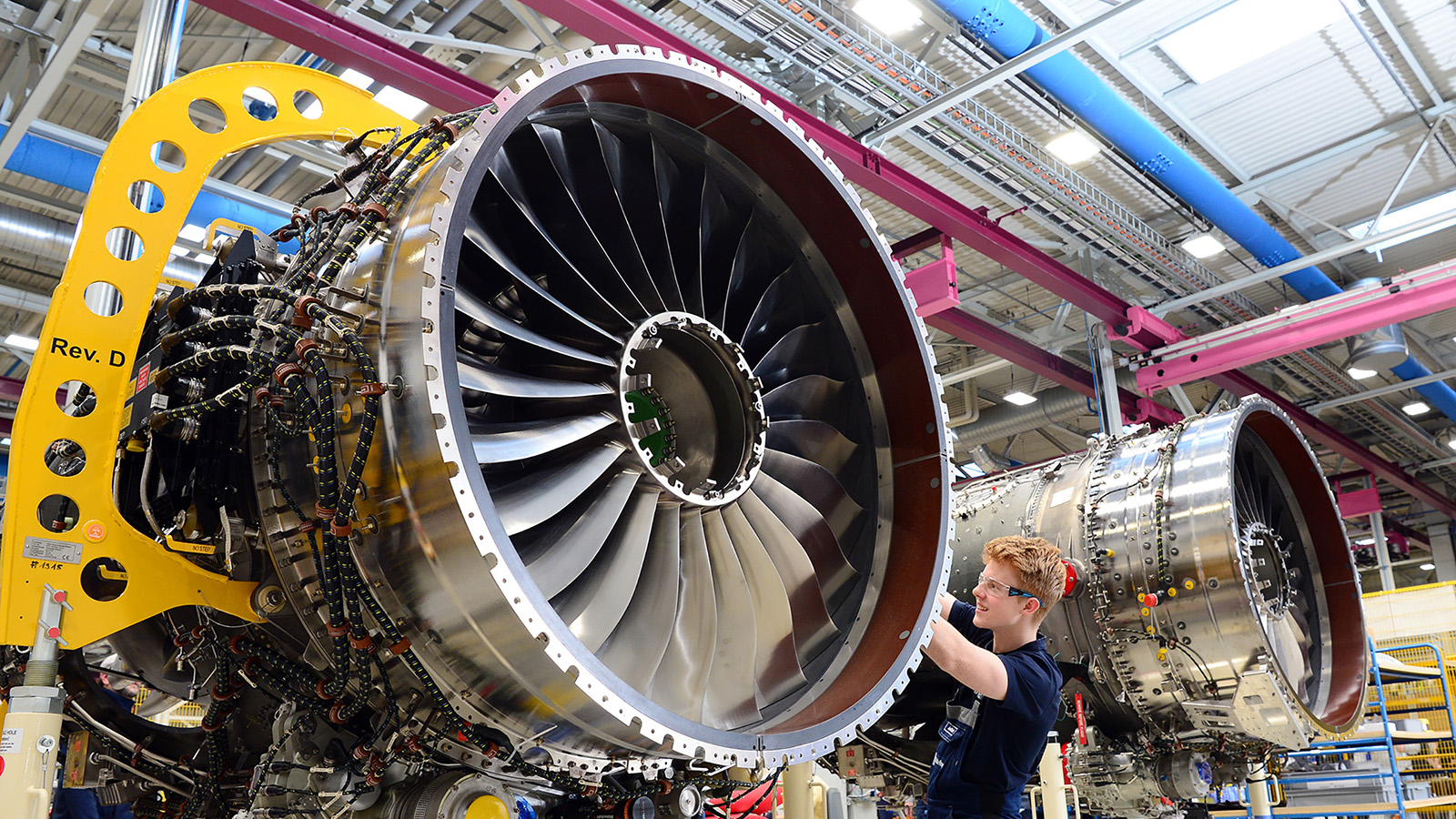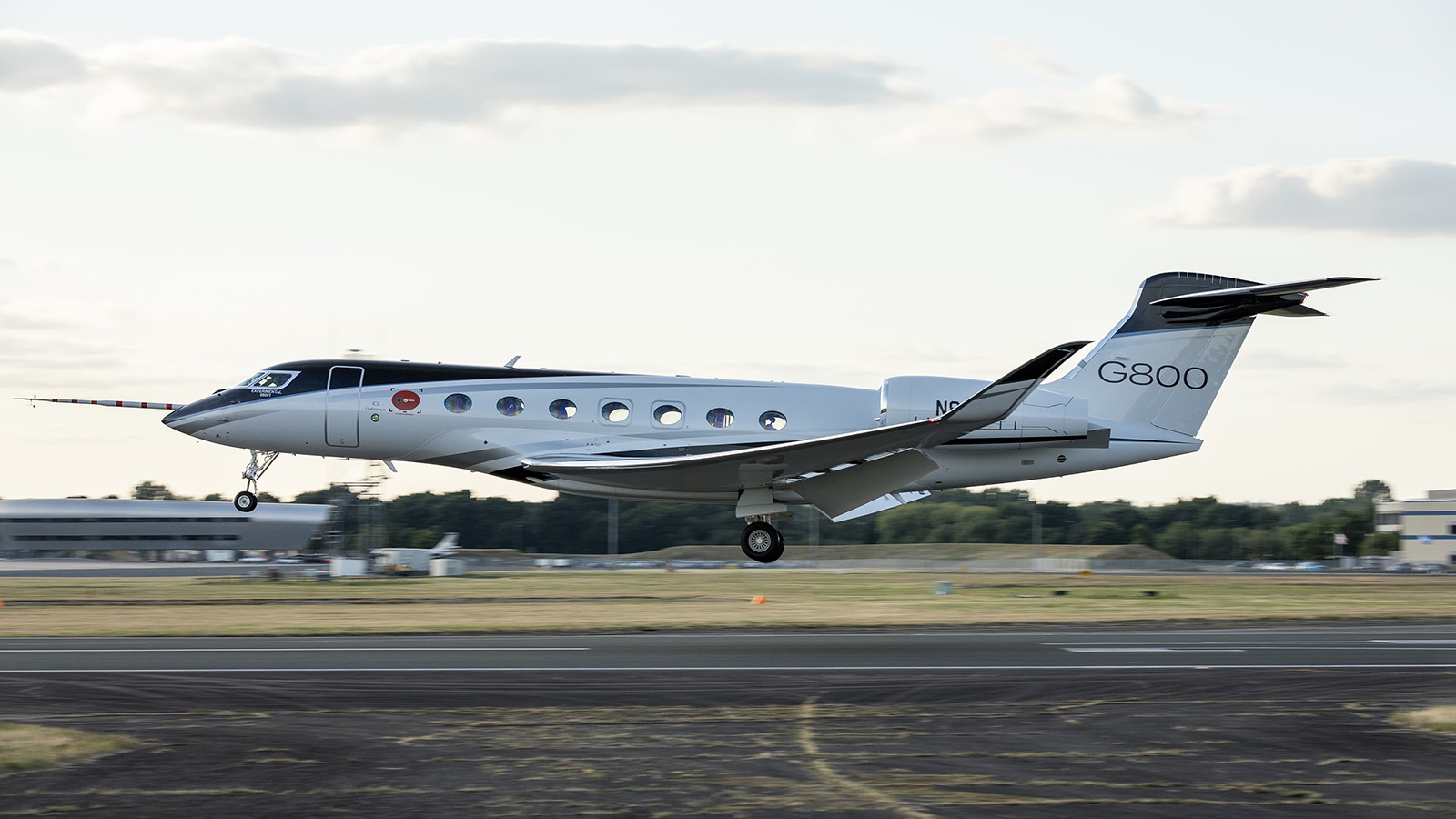Stay Up to Date
Submit your email address to receive the latest industry and Aerospace America news.
Flight testing is underway for the Gulfstream G800, slated to be the longest-range business jet yet produced. Perhaps fittingly, one of the first of those flights was a transatlantic trip. Aaron Karp tells the story of how Gulfstream delivered the G800 to the Farnborough International Airshow.
Gulfstream Aerospace executives gathered around a conference table in early May at the business jet manufacturer’s headquarters in Savannah, Georgia, to discuss the coming first flight of their newest aircraft, the G800. Capable of flying nearly 15,000 kilometers without stopping, the G800 would be the longest range business jet ever produced, surpassing the 14,300-kilometer range of the Bombardier Global 7500. The first of three test flight versions of the G800 was scheduled to take to the skies within two months — on June 28, to be specific.
Someone at the table said, “‘Hey, could we support Farnborough?’” recalls Tobias van Esselstyn, Gulfstream’s director of flight test engineering. It was a reference to the 74-year-old international air show where new designs are famously shown off to prospective customers. “And we all kind of looked at each other in the conference room and said, ‘Wow, that’s really a stretch goal.’” The 2022 show was scheduled to open July 18.
This is the story of how Gulfstream demonstrated to FAA and the United Kingdom’s Civil Aviation Authority that the first G800 aircraft could be flown safely from Savannah/Hilton Head International Airport in Georgia to Farnborough Airport in England — a nonstop flight of 6,680 kilometers — and do so just 17 days after a first flight that in May was still weeks away.
In the conference room, the consensus was that the chances of earning a special airworthiness certificate from FAA and meeting any additional operating limits from the U.K. in time were “pretty low,” recalls van Esselstyn.
Safety, of course, is Gulfstream’s top priority, so the short period of test flying between first flight and potential transatlantic flights would have to be rigorous. After a deadly crash in 2011 during certification testing of the G650, Gulfstream appointed an aviation safety official who reports directly to the company’s president and made numerous communications improvements.
“We now have test readiness reviews that really look, from a process standpoint, at whether the systems being tested are ready to go for this specific test flight,” van Esselstyn says. “How are you looking at the safety risk levels? Is the risk low, medium or high? If it’s high, we look at things we can do to lower the risk and safely perform the fight.”
There was one aspect of the G800 program that made approval for a transatlantic flight seem possible: The design is closely tied to that of the G700 aircraft already in flight testing. The two aircraft have just one major difference: The G700, flown for the first time in February 2020, is 33.48 meters long, while the G800 is shorter at 30.4 m. The G800 can fly farther, but the G700, with a range just shy of 14,000 kilometers, has space for more passengers in a roomier cabin.
The G800’s extended range will make possible more nonstop, long-haul routes. For example, Dubai to Dallas and both Los Angeles and New York to Hong Kong are quite feasible.

The similarities between the two aircraft, including a high level of automation on the flight deck, meant FAA and CAA could rely on data from the G700 flight test program — currently five G700 test aircraft are active — to help make the decision about whether the G800 was ready for a transatlantic flight.
“We’ve piggybacked off of more than two years and 3,000 hours of flight testing on the 700,” says Eric Holmberg, Gulfstream’s senior experimental test pilot and assistant chief developmental test pilot. “This was the first flight for the 800, but we had proven engines and technology from the 700 program.”
Both designs are powered by two Rolls-Royce Pearl 700 engines, a kind originally developed exclusively for the G700. Each engine provides an 8% increase in takeoff thrust compared to the Rolls-Royce BR725 that powers the earlier-generation G650 aircraft, and Rolls says the engine is 5% more fuel efficient than the BR725.
“If we didn’t have so much in common between the two aircraft, we wouldn’t have even thought of approaching the flight to Farnborough,” Holmberg says. “But it really worked out for us. We even surprised ourselves a little bit.”
He added: “In the end, we were able to convince ourselves and the authorities that, based on the maturity of the 700 program — the flight deck we pretty much just copied and pasted over to the 800 — the airplane was mature enough to make the trip over to Farnborough.”
But first, the G800 test aircraft had to complete its first domestic test flight.
Taking to the skies
Shortly before 9 a.m. Eastern U.S. time on June 28, the G800 was poised for takeoff from Savannah/Hilton Head Airport on its inaugural flight with Holmberg at the helm as lead pilot. In front of him was Honeywell’s SmartView avionics display, a design also on the G700. The SmartView software gives the pilot a live 3D rendering of the forward view. Synthetic imagery, such as a runway as it would appear on a cloudless day, is overlaid with metrics including altitude and airspeed readings to give pilots greater situational awareness, even at night or with little visibility.
The pilot can tailor the view via multiple touchscreens, eliminating the manual overhead buttons and switches that distinguished earlier-generation flight decks. Holmberg compares these avionics to smartphones or tablets.
“When you advance from all the hard buttons, both in the overhead panel systems and on all your avionics, to automation, it’s much more intuitive to use,” he tells me. “Think of your iPhone. Generally, things are easy to figure out and you know where the menus and apps are without having to look it up.
SmartView is active in all phases of flight. “So, you start off with a taxi route on the taxiways and runways, then you take off and the route is set,” Holmberg says. “On arrival, all the tasks are clearly laid out. After I land, the system will tell me if I need to hit the brakes.”

On the first flight, Holmberg took the G800 up for an initial test of its flying qualities. The aircraft soared as high as 45,000 feet and cruised at Mach 0.85. That’s below the advertised Mach 0.925 flight envelope for the G800 but was necessary for testing and safety purposes on the two-hour flight.
“We’ve really got a lot of power to work with,” Holmberg says, citing the Pearl 700 engines and the aerodynamic advantage over the larger G700. “In the 800, you can climb up higher quicker and get above the weather.”
The flight “went great without a hitch,” he says. Suddenly, Farnborough seemed more possible.
Transatlantic vision
To get approval for the trip, Gulfstream would have to fly the G800 at least 25 hours between that first flight and the trip to Farnborough.
“We got 25 hours on the airplane as quickly as we could,” van Esselstyn says. The eight flight tests included a six-hour one in and out of Savannah.
Gulfstream gained approval to fly across the Atlantic. The trip would be just the aircraft’s 10th flight (the June 28 inaugural flight plus the eight flights that followed). With Holmberg as lead pilot, the aircraft was ready to start the trip on July 15.
“We took off and climbed straight to 45,000 feet. We were carrying about 15,000 pounds more fuel than we needed in case we had to divert. But the airplane really behaved like an in-service aircraft,” Holmberg says. “It surprised us that the flight was so simple and so easy.”

Once Gulfstream begins to push the G800 flight envelope, it should fly as high as 51,000 feet.
The aircraft touched down that evening at Gulfstream’s service center at Farnborough Airport, a little over six hours after taking off and after cruising at Mach 0.85. When the show started three days later, it was on static display. Holmberg noted that because there hadn’t been an in-person Farnborough Airshow since 2019 due to the covid-19 pandemic, there was an eagerness by attendees to see new aircraft.
“We had a steady flow of media and prospective customers coming to see the G800,” he says.
Gulfstream is now moving toward certification of the G700 and G800 with a dual flight test program. Pending FAA approval, G700 certification and first delivery are slated for 2023, while G800 certification and first delivery are planned for 2024.
Opening image: A Gulfstream G800 test aircraft touched down at Gulfstream’s support center at Farnborough Airport on July 15. The transatlantic flight from Savannah, Georgia, occurred a little over three weeks after the design’s first flight on June 28. Credit: Gulfstream
About Aaron Karp
Aaron is a contributing editor to the Aviation Week Network and has covered the aviation business for 20 years. He was previously managing editor of Air Cargo World and editor-in-chief of Aviation Daily.
Related Posts
Stay Up to Date
Submit your email address to receive the latest industry and Aerospace America news.




